In the eastern tradition, the term “altar” is a synonym for “sanctuary.” Substitute the word as you read the following passage from St. Germanus, and it will make more sense:
The altar corresponds to the holy tomb of Christ. On it Christ brought Himself as a sacrifice to [His] God and Father through the offering of His body as a sacrificial lamb, and as highpriest and Son of Man, offering and being offered as a mystical and bloodless sacrifice, and appointing for the faithful reasonable worship, through which we have become sharers in eternal and immortal life. This lamb Moses prefigured in Egypt “towards evening” when its blood turned back the destroyer so that he would not kill the people (cf Ex 12:7-13). The expression “towards evening” signifies that towards evening the true lamb is sacrificed, the One who takes away the sin of the world on his cross, “For Christ, our Pascha, has been sacrificed for us” (cf I Cor 5:7).
The altar is and is called the heavenly and spiritual altar, where the earthly and material priests who always assist and serve the Lord represent the spiritual, serving, and hierarchical powers of the immaterial and celestial Powers, for they also must be as a burning fire. For the Son of God and Judge of all ordained the laws and established the service of both the heavenly and the earthly (powers).
We’ve discussed some of this already, here and here. In summary:
1. Sanctuary as Christ’s Tomb: The traditional apse form of the sanctuary images Christ’s tomb which was located in a garden. Thus the sanctuary is to the church building what the tomb is to the New Eden: the place where the sin of Adam is undone. Garden imagery is therefore abundant.
2. Sanctuary as Place of Paschal Sacrifice: Christ’s sacrifice was prefigured in the Passover Lamb, of which God commanded: “the whole assembly of the congregation of Israel shall kill it in the evening” (Ex12:6). This fact may (I’m speculating) help explain why the Holy Place in the Temple at Jerusalem, which contained the golden altar, was placed on the west side of the complex, with the setting sun, so that the place of the Passover ritual would correspond with the time of the event commemorated.
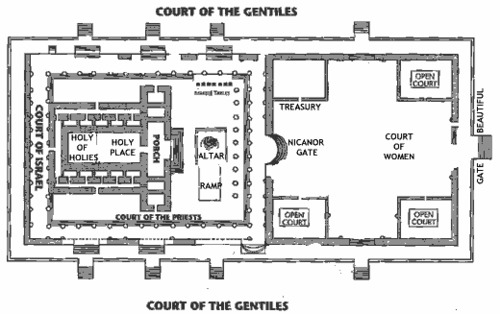
Plan of the Temple at Jerusalem. North is up, and the Holy Place and its golden altar are to the west..
At the same time, it was in the evening before His betrayal that Christ, at the Last Supper, was both priest and sacrificial lamb–in the Cenacle on Mount Sion. The Cenacle was the most important synagogue in all Jerusalem, located as it was over the tombs of King David and the mysterious priest Melchisedech, offerer of bread and wine. After Pentecost, it became the first Christian church, home of the Liturgy of St. James. All synagogues are abbreviations of the Temple as they were invented during the Babylonian captivity to carry on the ceremonial of the Temple, sacrifice excepted: they are composed of a porch, a nave, and a sanctuary or bema. The bema is always oriented toward the Temple.
Thus, there were two models for Christian church buildings: the Temple and the synagogue. The sanctuaries of the earliest post-Constantinian churches in Christendom, most prominently St. Peter’s in Rome, imitated the westerly location of the Holy Place in the Temple.
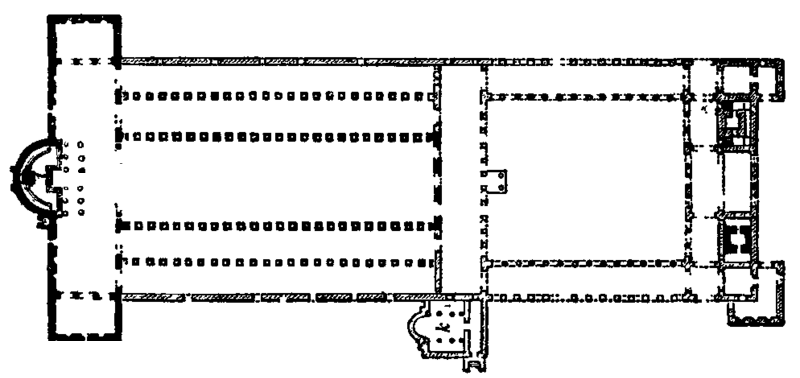
Plan of Old St. Peter’s as constructed by Constantine. North is up and the Sanctuary is to the west.
The church buildings which imitated the synagogue, however, took a different tack. While the synagogue’s bema pointed to the Temple, the church building’s sanctuary now pointed east. The direction of Christian prayer was always toward the east–ad orientem. In the words of St. John of Damascus, “we worship God seeking and striving after our old fatherland,” i.e., the Garden of Eden. We also face east in expectation of the Second Coming:
For as the lightning cometh out of the east, and shineth even unto the west; so shall also the coming of the Son of man be.
(Matthew 24:27)
This was so even when the sanctuary of the church building was located to the west–the congregation simply turned around and faced east. The nice thing about placing the sanctuary to the west is that the building itself faces east, both to imitate Paradise lost (whose gate was in the east), and to join in the direction of striving.
Placing the sanctuary in the east, on the other hand, has certain advantages. For one, there is now no need for those hearing Mass to turn around, putting the altar behind them. Also, the whole movement toward the church, through the preparatory forecourt, into the nave, and toward the Sanctuary boundary for Holy Communion is now an eastward movement–the whole is now a striving for our fatherland. The movement is from darkness, the sun’s setting, toward light, the sun’s rising. From birth in Original Sin, to death in Sanctifying Grace. St. Germanus’s own cathedral Hagia Sophia imitates the synagogue.
The sanctuary of the New Covenant is a spiritualized version of the Old Testament Holy Place. Where the fire was carnal, now it is spiritual. The material liturgy mirrors the heavenly, and as such the sanctuary is as close to heaven as it is possible in this life to be.

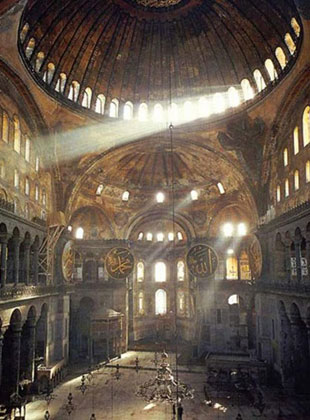
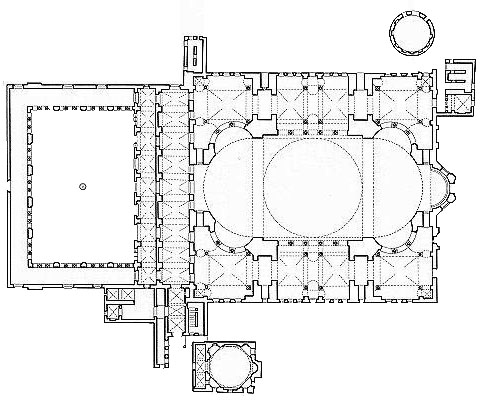
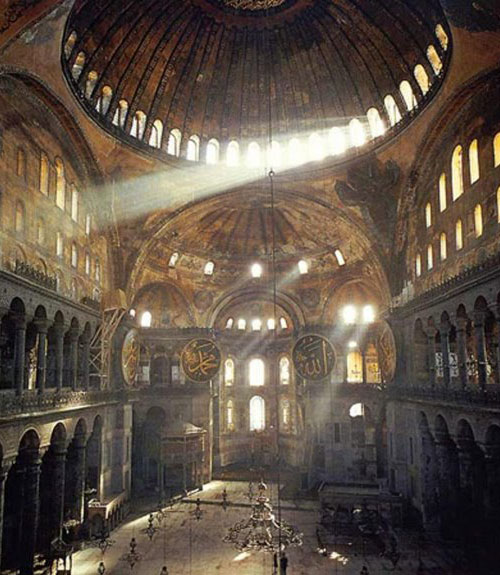
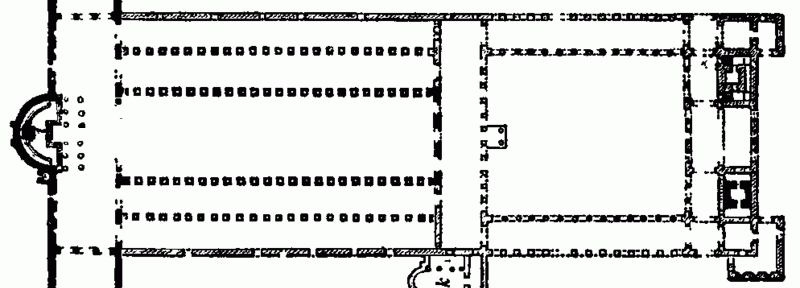
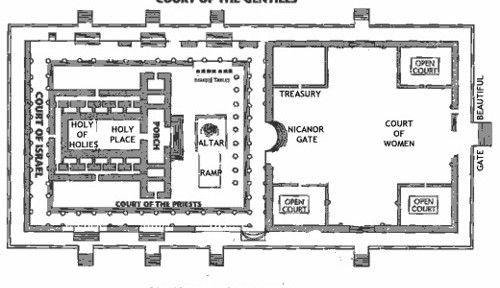
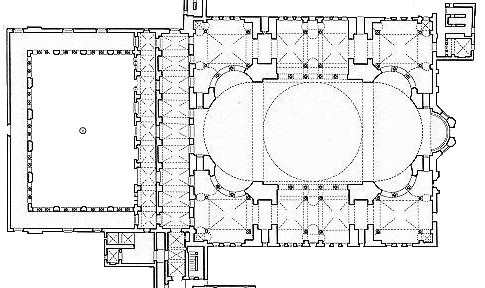
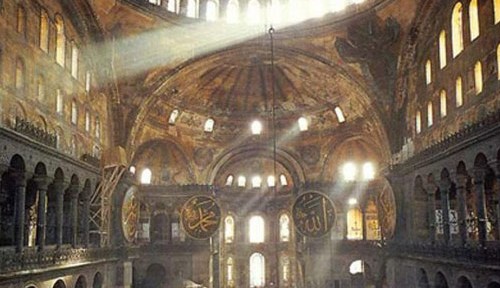
Great and useful summary. I would suggest, though, that the modern decision about the orientation of the sanctuary relative to the nave is based on a less noble analysis than yours. It is more likely to be based on whether or not the “audience” regards the priest as performer or concelebrant.
You are right that the whole idea of ad orientem worship has been practically forgotten. It's been replaced with the community gathering.
Mr. Marcantonio,What would you suggest in the case of my parish church in which the priest, facing versus populum, faces East at the consecration because the sanctuary faces West?
I am not a liturgist, so please take this with a grain of salt. There are two options, it seems to me. One, the congregation can turn around (at the Canon) and everyone faces east as they would have done in antiquity (in some churches). This, however, is not such a culturally viable option. Or two, they can do the practical thing and what has been done historically: the priest can offer Mass from the other side of the altar so that all are facing the same direction. While that direction is literally west, it would be notional east for the purposes of the liturgy. Hence, the sanctuary end of the church is called liturgical east. This is the situation in many (if not most) church buildings which, due to site conditions, could not be properly orientated. The churches of Rome, for example, are facing all sorts of directions.
Buongiorno, mi permetto di far osservare all’architetto Marcantonio che far risalire e dipendere la genesi formale e sostanziale delle chiese cristiane dai due modelli precedenti del tempio e della sinagoga è superficiale e non esaustivo. Materialismo riduttivo, una specie di darwinismo applicato all’indagine formale architettonica. La basilica romana dove è finita. La sinagoga non lascia traccia di se e non poteva essere altrimenti, il tempio pagano poi non ricompare se non nel quattrocento italiano. La verità è che l’architettura ecclesiale è una creazione ex novo da subito, assolutamente originale e nuova, sintesi di mondo e divino, nuovo e vecchio, alto e basso, apertura e chiusura e soprattutto è un nuovo inizio.Perdonate se non traduco in inglese questo contributo. Anche la lingua italiana merita di essere conosciuta. Grazie e Davide
Grazie tante per il contributo, Davide. Non sono mai stato accusato del materialismo riduttivo e del Darwinismo! Sono d'accordo che la basilica romana è fondamentale per rispetto alla forma della chiesa. Qui stavo parlando solo del significato del santuario e della sua orientazione, basando l'argomento nel testo di San Germano. La chiesa cristiana è una tipologia nuova, è vero, però ha i suoi radici nella storia architettonica e liturgica. Non è stato inventato ex nihilo. Pure, come ci fa ricordare San Germano, la nuova dispensazione è l'adempimento della vecchia. Perciò si può sempre vedere le forme anticipatrici della vecchia dispensazione nel nuovo.